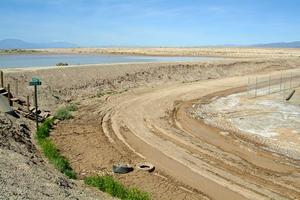LeveesRural California country faces levee dilemma
About 400 homes and rich farmland in District-10 of Marysville, California risk being flooded should the levees protecting the area fail. The levees, stretching over twenty-eight miles, were built in the early 1900s. The area’s low population may be one reason why county officials have neglected making improvements to the levees in District-10. Local opponents of investment in shoring up the levees are worried that if the levees are improved and the area made safer, “It would open the door for more agribusiness type things, but it would also open the door for more subdivisions,” in the words of one of them.

a stretch of California levee in need of repair // Source: commons.wikimedia.org
About 400 homes and rich farmland in District-10 of Marysville, California risk being flooded should the levees protecting the area fail. The levees, stretching over twenty-eight miles, were built in the early 1900s. The area’s low population may be one reason why county officials have neglected making improvements to the levees in District-10.
The Appeal Democrat reports that that populated areas are given priority when it comes to flood protection. Former Yuba County supervisor Don Schrader, a resident of District-10 who recently announced his plan to run for a seat on the Board of Supervisors next year to represent the 5th District, is bringing attention to the twenty-eight miles of levee he says need improvement.
“Yuba County has ignored everything north of Marysville for years,” Schrader told the Appeal Democrat. “It’s an issue that is absolutely critical to Yuba County.”
Roughly forty District-10 farm-related businesses have a total value of $170 million, according to estimates by Agricultural Commissioner Luis Mendoza. Losing the agribusinesses to flooding would damage the county’s farming industry. “A levee break in District-10 would be devastating to the county agricultural economy,” said Schrader. “It would be an exorbitant cost to rebuild those businesses.”
Mendoza acknowledges the importance of keeping the agribusinesses in District-10. “It is important to do what we can to protect those facilities up there in the District-10 area,” he said. “There is a lot of commodities and a lot of shipping and drying up in that area.” The value of crops from District-10 averages $41 million annually. The figure increase substantially when shipping and drying facilities in the district are factored in.
Schrader is asking the County Board of Supervisors to fund an inundation study and a survey of the levees to determine their condition.
Supervisor Hall Stocker, representing District-10, is concerned that upgrading levees would open the door to residential development. “Agriculture is the number one economic asset in Yuba County and District-10 is a big part of that,” Stocker, who often opposes building subdivisions on farmland, told the Appeal Democrat. “It would open the door for more agribusiness type things, but it would also open the door for more subdivisions.”
District-10 carries a natural resources land-use designation, which requires that four out of five members of the Board of Supervisors vote to revoke it in order to allow residential development. Schrader does not anticipate that existing agribusinesses would sell their land for development if the levees were shored-up. “We are not trying to fix the levees so we can build homes,” he said. “We would be doing it so we can protect businesses.”
